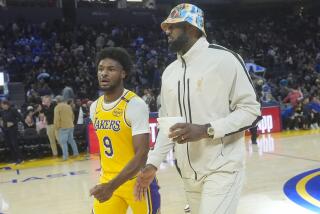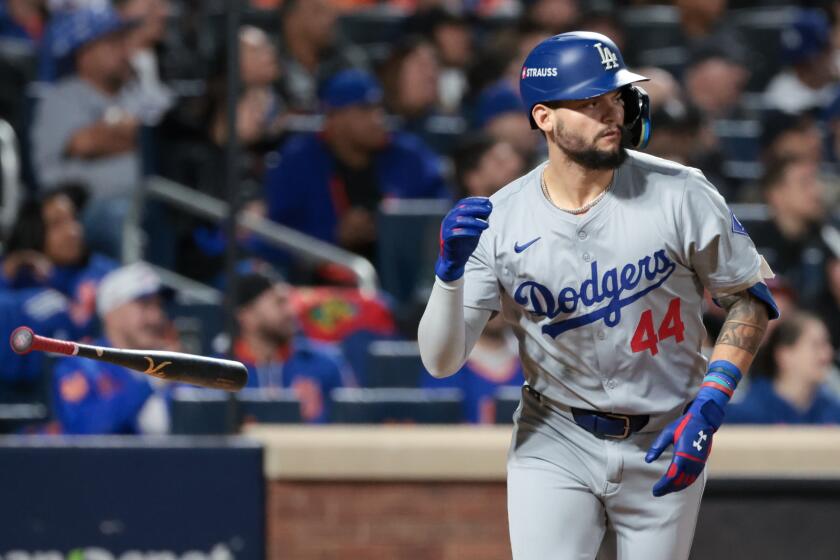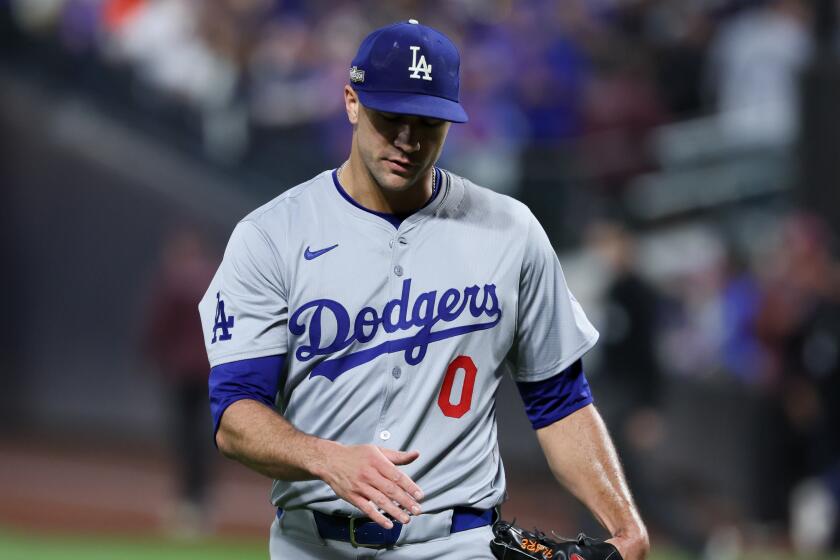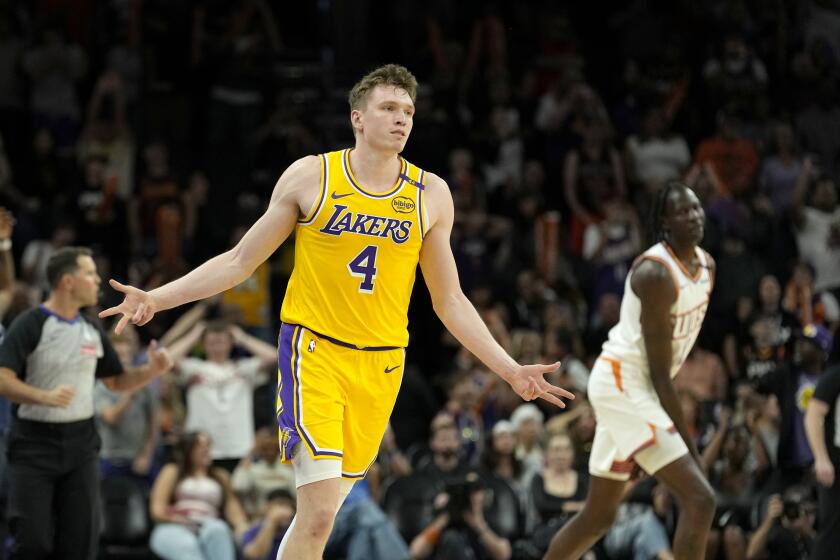COLLEGE BASKETBALL ‘88-89 : WHAT HAS HAPPENED TO ALL THOSE : HOT SHOTS : Emergence of 3-Pointer May Force Issue As Players and Coaches Open Up to the Sport’s Long-Range Potential
Remember when basketball was played on this huge court, and the players used all of it? Guys would pound the ball down to about 20 feet from the basket, pull up as if they’d hit some kind of trip wire and let fly these magnificent trajectories, long, arcing shots that seemed to whistle through the air. Remember?
No?
It was a long time ago, back when they still used peach baskets and you couldn’t identify a basketball team just by the way the players ducked going through doorways. Basketball was then long distance, horizontal not vertical, short and clumsy guys who happened to have the gift and nerve of a sharpshooter, dialing it up, one area code to the next.
And then the game got what you might call compacted. These marvelous athletes, having elbowed that short and clumsy guy back into lacrosse where he belonged, were performing all kinds of gymnastics in a 10-foot zone around and about the basket--dunks that were described in degrees, 180s for a starter-dunk, 360s for the accomplished; and arrogance, facials being a favorite.
It was fun to watch all these athletic pyrotechnics. Leaping, twisting and behind-the-back-passes. Everything designed to bring the ball into every coach’s comfort zone: right under the basket.
But for all the space the game took, it could have been played in a phone booth. A guy who took a 20-footer might as well have dialed 911. He was in trouble.
And now guess what. After being nudged by the old American Basketball Assn., the National Basketball Assn. passes a 3-point rule, the colleges follow suit and even the high schools take it up. Here comes that guy up to, oh, about 20 feet and--boom! We’ve got shooters again! And, coaches say, we’re going to have lots more.
Basketball is that rare sport that establishes philosophies and passes legislation from time to time to accommodate the changing pool of talent. It’s no wonder, when you think about it, that basketball shrunk in the first place. No. 1, these wide open spaces were, well, maybe too wide open.
Going back to the good old days, it’s important to remember that all those long, arcing shots, as thrilling as they might have been to watch, had a random element to them. There was no certainty, even among the best shooters, that the ball would go anywhere near the basket.
Bob Cousy might not have been the guy you wanted to shoot an apple off your head, but for his time in the NBA, basically 1950-63, he was a typical shooting guard, even a Hall of Fame player. His lifetime shooting percentage was 37. Thirty years ago in the NBA, few could make even half their shots.
But then, and this applies to NBA and college basketball, the game became more athletic.
“It became more of a jumping game,” says Pete Newell, former Cal coach and now adviser to the Cleveland Cavaliers. “It’s become a game when they did shoot, it was from about 16 feet at most.”
As players got better and the talent pool deeper, so too did they get bigger. Would you rather have Cousy shooting his 1-in-3 shot or Wilt Chamberlain lifting the ball over his head for the surest shot in the game? Would you like this same job next year?
It was an easy decision for coaches to make. The passing game became the thing to teach. Pound the ball inside for that sure shot.
“If you’re gonna beat me,” says Newell, repeating every coach’s favorite axiom, “you’re gonna beat me over the top.”
This did two things:
--It gave the coach, who never did believe he was fully in charge of matters, a new sense of control. He could draw pictures on his clipboard during timeouts and bark instructions.
“A lot of guys want to have a role,” explains ESPN analyst Dick Vitale.
You can almost see him rolling his eyes. So there were traps, screens, all manner of technical things to get the ball inside.
Says USC Coach George Raveling: “It became more of a coaching philosophy, the higher percentage shot. In reality, it gave coaches a feeling of comfort.”
Also, they could conduct clinics.
--The other thing this style of basketball created was the playground hero.
” . . . What you see are kids all wanting to do the 360, the slam dunk,” Vitale says. “They’re emulating Michael Jordan. As a result, I definitely feel shooting has become a lost art.”
Nobody practiced it. In the movie “Hoosiers,” set in the early 1950s, the nostalgic point of view is indicated by an early scene of a boy practicing basketball on an outdoor court. He is shooting long set shots. That’s how you know it is the early 1950s. By the 1970s, such a scene would be laughable. The boy would be dunking behind his head.
Jerry West, who took a long shot from time to time, first at West Virginia and later with the Lakers, says: “Kids got used to playing that. Kids do what’s popular.”
That’s the short history of basketball. Except that some unattractive aspects to the “new” game began to develop.
Lute Olson, the Arizona basketball coach, says: “Everything became predicated on powering the ball to the inside.”
And it got too crowded. Zones collapsed and the knot of players under the basket acquired the density of a black hole. Also, the same attraction.
Then in 1987, the National Collegiate Athletic Assn. nationally standardized the 3-point rule, what Newell calls the “biggest rule change since the elimination of the center jump.”
Now there was a legislated encouragement to let fly. The immediate problems were these: players, not having spent their lives practicing from any distance, tossed bricks; coaches, alarmed by the prospect of anything but a safe shot and secretly pleased by the low percentage of their perimeter shooters, were reluctant to change.
“Look,” a coach might say, pulling some statistics from his clipboard. “In 1986, NCAA basketball shot an all-time high of 47.7%, up steadily over the years from 43.8% in 1968. Then, with the 3-point shot in effect, percentages dipped--fell off a cliff actually--to 46.4.”
Besides this reliance on recent history, conservative coaches also had the example of international basketball to trot forth. These foreign teams, they had no athletic skills, couldn’t jump, couldn’t dunk a doughnut. And what happened to them when the mighty United States played them?
“The feeling is it’s our game,” says Raveling, an assistant on our last two U.S. Olympic teams. “Those other fools can do it that way. That’s fine.”
And it was. The United States always won.
Yet there was math to contradict this point of view and, finally, the 1988 Olympics, when those “fools” beat the Americans, they drilled their eyes out.
The reality, as Newell explains, is that the 3-point shot that can be sunk 40% of the time is the same as a 2-point shot that can be made 60% of the time.
“As a result, college coaches are looking at players a little differently,” he says. “For that inside game to still go, you need a real threat at the perimeter. Now, you have to have accurate 3-point shooters on each side so you can have lateral movement.”
Certainly the rule has caused coaches to think. Olson says the thinking used to be that you could score 3 points more easily by penetration--the easy shot and the foul.
“Maybe they thought that rightfully, but now the opportunity to score 3 points (outside) is far greater,” he says. “To get 3 inside, the chances are minute.”
These were good times for a coach like Olson, who says he never had trouble with the game’s stealth bombers.
“I’ve personally never felt that a pressured 6-footer was better than an 18-foot open shot. Also, if you have your guards shooting, you have three potential rebounders. With a turnaround jumper, you’ve lost a third of your rebounding strength.”
The only question, where were these shooters?
The example of the Olympics, where the outside shooting “fools” finally prevailed over a stone-cold shooting U.S. team, may galvanize the troops.
Selection might have been a problem, although Olympic coaches may not be as stodgy as some believe. Indiana’s Bob Knight, the 1984 coach, finally took to the 3-point shot when Steve Alford came along. More likely, there aren’t many practiced shooters.
But that’s changing, too, says Olson, who managed a 35-3 record last year, in no small measure thanks to Steve Kerr, a 57% shooter from the 3-point line. Olson says the biggest impact on the college game is not the introduction of the 3-point rule at the college level but in high school ball.
“You didn’t used to see many kids who could make it,” he says. “But I’ve noticed it now, traveling to various camps, where you see the premium placed on the ability to shoot the perimeter shot.
“I personally see a big difference in the concentration of players when you view kids on playgrounds or even shooting prior to practice. Now the emphasis is on whether you can hit the 3-pointer, not make the dunk.”
As these kids master the distance, coaches may be less and less reluctant to let them open up. A new coaching reality will demand it, Newell says.
“Some will still hold to that thing, get that ball inside. But some of those same coaches are going to find out that their defenses haven’t adjusted and they aren’t getting enough inside shots.”
They’ll be losing, is the bottom line.
If the coaches will be different, it is reasonable to ask if the players will be different. With the 3-point shot an important offense, we don’t need these athletic whirling dervishes, right? Those short, clumsy guys--Steve Kerr?--the ones with the gift of a sharpshooter will be the new heroes.
“Or more likely,” Olson says, “if those athletes are truly good athletes, they’ll be making the 3-point shot,” instead of the short, clumsy guy, who is still playing lacrosse as far as we know.
In any event, the game is changed forever, or until the next rule change. Newell notes that the 3-point play and the player who can make them will turn mismatches into games you can’t really disregard.
“A 12-point lead is now just 4 baskets,” he points out. “It will be hard for the fan to leave early now.”
More to Read
Go beyond the scoreboard
Get the latest on L.A.'s teams in the daily Sports Report newsletter.
You may occasionally receive promotional content from the Los Angeles Times.










